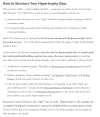I’m sorry but what you’re saying here simply isn’t true, the fundamentals of strength and hypertrophy training are to a certain extent polar opposite, although it is true to say that many people achieve success in both using hybrid approaches. If your focus is strength you will workout with lower reps, longer rest periods, staying away from failure in order to stay as fresh as possible. If your focus is hypertrophy you will workout with higher reps, shorter rest periods, working closer to failure aiming to get fatigued. As I say, many/most people want to achieve strength and hypertrophy or unwittingly go down that path by selecting popular programs designed as hybrids. But hybrids by their nature are not optimal for either goal. For example, if your goal is purely strength you wouldn’t choose 531 or StrongLifts because they provide insufficient reps near your top weight for optimal strength development. And if your goal is purely hypertrophy you wouldn’t choose 531 or Stronglifts because they provide insufficient volume for optimal muscle building. Yet many people whose goal is strength and hypertrophy enjoy their success using those programs


